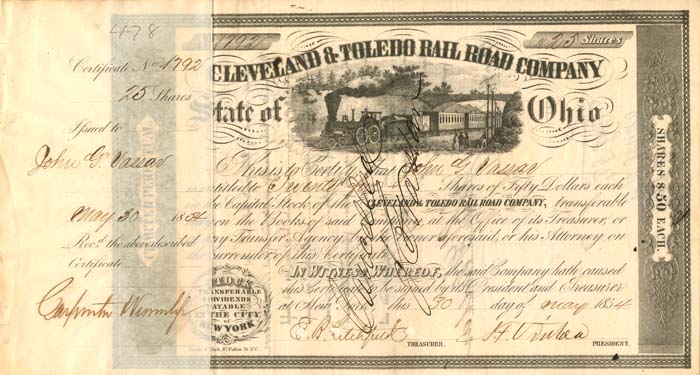John G. Vassar - Cleveland and Toledo Rail Road - Stock Certificate
Inv# AG1673 Stock
Stock signed by John G. Vassar on the back and transferred to Matthew Vassar, Jr. Matthew Vassar (April 29, 1792 – June 23, 1868) was an English-born American brewer and merchant. He founded the eponymous Vassar College in 1861. He was a cousin of John Ellison Vassar. He was born in East Dereham, Norfolk, England. In 1796, he emigrated with his family to New York and settled on a farm near Poughkeepsie. When Vassar was 14 years old, his parents had him apprenticed to a tanner. One day before he was to begin his apprenticeship, he ran away to Newburgh, New York, subsequently entering the brewing business. He took over his family's small brewery at the age of eighteen. Over the next several decades he developed his Poughkeepsie brewery into one of the country's largest, by the 1830s becoming perhaps the first to achieve nationwide distribution to every state and amassing a sizable personal fortune in the process. Lydia Booth, a niece of Matthew Vassar, encouraged him to establish a women's college in the United States, which would be located in Poughkeepsie. In January 1861, the New York Legislature passed an act to incorporate Vassar College, one of the first women's colleges in the U.S. On 26 February 1861, Matthew Vassar presented the college's Board of Trustees with a tin box containing half of his fortune, $408,000 (approximately $9,700,000 in 2008 dollars) and a deed of conveyance for 200 acres of land to establish the campus. On June 23, 1868, Vassar delivered his farewell address to the Vassar College Board of Trustees; he died in the middle of delivering the eleventh page of the speech. In a bill enacted on 15 July 1870, the U.S. Congress waived any tax claim(s) to the donation to the college. Matthew Vassar's home, Springside, located south of Poughkeepsie, is a National Historic Landmark. Rare!
The Junction Railroad was chartered March 2, 1846, to build from Cleveland west to Toledo. The Toledo, Norwalk and Cleveland Railroad was chartered March 7, 1850, to build from Toledo east to Grafton on the Cleveland, Columbus and Cincinnati Railroad. The latter company opened on January 24, 1853, finally forming a continuous Buffalo-Chicago line. On September 1 the two companies merged to form the Cleveland and Toledo Railroad, with the Junction Railroad becoming the Northern Division and the Toledo, Norwalk and Cleveland the Southern Division. The Northern Division opened from Cleveland west to Sandusky on October 24, 1853, and the rest of the way to Toledo on April 24, 1855. The Northern Division was abandoned west of Sandusky due to lack of business, but the track was relaid in 1872, merging with the Southern Division at Millbury, east of Toledo. In 1866 the Southern Division east of Oberlin was abandoned and a new line was built to Elyria on the Northern Division, ending the use of the Cleveland, Columbus and Cincinnati Railroad.
In October 1867, the Cleveland, Painesville and Ashtabula Railroad leased the Cleveland and Toledo Railroad. The CP&A changed its name to the Lake Shore Railway on March 31, 1868, and on February 11, 1869, the Lake Shore absorbed the Cleveland and Toledo. On April 6 the Michigan Southern and Northern Indiana Railroad and Lake Shore merged to form the Lake Shore and Michigan Southern Railway, which absorbed the Buffalo and Erie Railroad on June 22, giving one company the whole route from Buffalo to Chicago. The main route passed through Dunkirk, NY, Erie, PA, Ashtabula, OH, Cleveland, OH, Toledo, OH, Waterloo, IN and South Bend, IN. An alternate route (the Sandusky Division) in Ohio ran north of the main line between Elyria and Millbury (not all track was laid until 1872). From Toledo to Elkhart, the Old Road ran to the north, through southern Michigan, and the through route was called the Air Line Division or Northern Indiana Air Line. Along with various branches that had been acquired (see below), the Monroe Branch ran east from Adrian, MI to Monroe, where it intersected the leased Detroit, Monroe and Toledo Railroad. At some point the original line to Toledo was abandoned west of the branch to Jackson, MI (Palmyra and Jacksonburgh Railroad), with the new connection at Lenawee Junction, the crossing between that branch and the line to Monroe.
A stock certificate is issued by businesses, usually companies. A stock is part of the permanent finance of a business. Normally, they are never repaid, and the investor can recover his/her money only by selling to another investor. Most stocks, or also called shares, earn dividends, at the business's discretion, depending on how well it has traded. A stockholder or shareholder is a part-owner of the business that issued the stock certificates.









Ebay ID: labarre_galleries